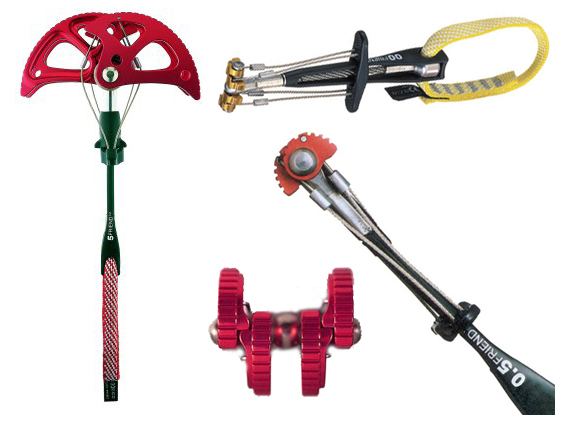 | ||
A spring-loaded camming device (also SLCD, cam or friend) is a piece of rock climbing or mountaineering protection equipment. It consists of two, three, or four cams mounted on a common axle or two adjacent axles, so that pulling on the axle forces the cams to spread farther apart. This is then attached to a sling and carabiner at the end of the stem. The SLCD is used by pulling on the "trigger" (a small handle) so the cams move together, then inserting it into a crack or pocket in the rock and releasing the trigger to allow the cams to expand. A pull on the rope, such as that generated by a climber falling, will cause a properly placed SLCD to convert the pulling force along the stem of the unit into outwards pressure on the rock, generating massive amounts of friction and preventing the removal of the unit from the rock. Because of the large forces which are exerted on the rock when an SLCD is fallen on, it is very important that SLCDs are only placed in solid, strong rock.
Contents
History
Vitaly Abalakov's invention of the Abalakov Cam was the first application to climbing of the principle of a constant-angle curved surface, with a cam shape based on the mathematical logarithmic spiral. Using a logarithmic spiral shape results in a constant angle between the cam and the rock at each contact point; this constant angle is designed to always provide the necessary friction to hold a cam in equilibrium. Designed so that a load produces a rotational force, the logarithmic cam shape allowed for a single device to fit in a range of crack sizes without a change in the loading pattern, making it predictable and stable.
In 1973 Greg Lowe filed for a patent for a spring-loaded version of the Abalakov Cam.
Modern SLCDs were invented by Ray Jardine in 1978 (US patent 4,184,657) and sold under the brand name of "Friends". Ray designed a spring-loaded opposing multiple cam unit with a more stable 13.75 degree camming angle and an innovative triggering mechanism. (The term friend is now widely used by climbers to refer to SLCDs in general, but properly speaking it refers to the brand now manufactured by Wild Country.) Other popular brands include Black Diamond Camalots, Metolius Power Cams, DMM 4CUs, Trango FlexCams, and CCH Aliens.
Modern use
The invention of SLCDs revolutionized rock climbing because it meant that parallel or flared cracks could be protected. Furthermore, unlike pitons, SLCDs can be removed easily without causing damage to the rock, which made clean climbing (climbing without damaging the rock) practical on many more climbs. Since the invention of the Technical Friend (which replaces the original one-piece machined alloy shaft with a brazed assembly incorporating a length of thick stainless-steel cable, which is better able to cope with loading over an edge), there has been a great deal of development of the SLCD by a variety of manufacturers. For example, the adoption of the dual axle design by Black Diamond, the invention of three-lobed camming units to fit smaller cracks, and the more recent invention of the Link Cam by Omega Pacific, a design that allows one SLCD to span an even larger range of crack sizes. SLCDs are sold in various sizes to fit a diverse range of cracks from about 6–300 millimetres (0.2–10 in) wide, though devices of below about 10 millimetres (0.4 in) or above about 100 millimetres (4 in) are not often seen.
Modern traditional climbers often climb with numerous and variously sized SLCDs to cover a wide range of crack sizes, sometimes with duplicate units depending on protection requirements of the climb.
